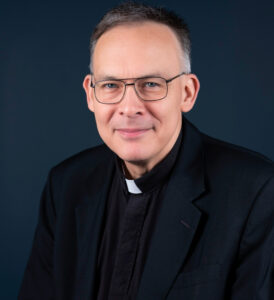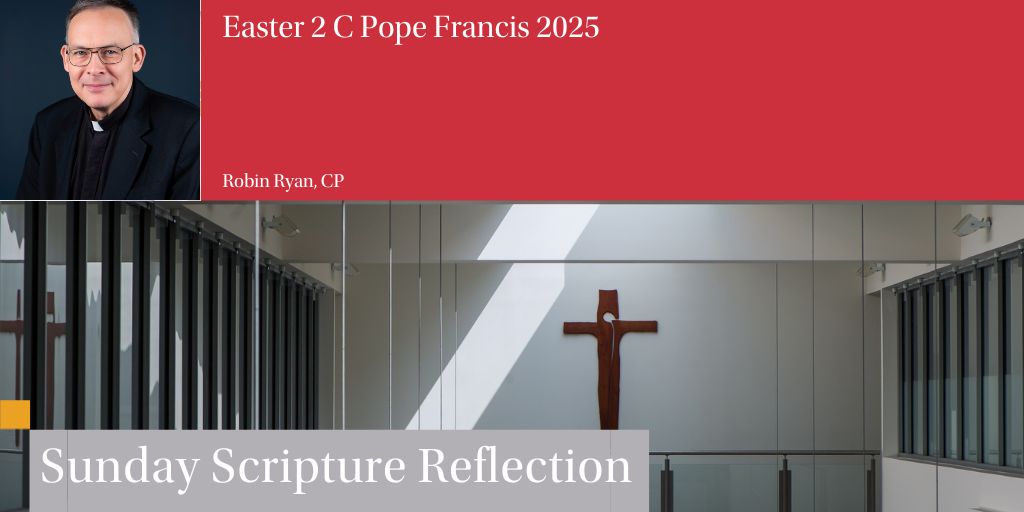
Readings:
Acts 5:12-16
Psalm 118:2-4, 13-15, 22-24
Revelation 1:9-11a, 12-13, 17-19
John 20:19-31
Every year, on the Second Sunday of Easter, we hear the famous story of “Doubting Thomas.” Thomas is incredulous when the other disciples tell him about their encounter with the Risen Christ on the evening of the first day of the week. He lays out a condition for his own coming to faith in the Risen Lord: “Unless I see the marks of the nails in his hands and put my finger into his side, I will not believe.” When Jesus again shows himself to these disciples the following week, he invites Thomas to touch his wounds. It is because of this direct encounter with the Risen Lord that Thomas is moved to make one of the most sublime professions of faith in the entire New Testament: “My Lord and my God.” Jesus then says to the no-longer-doubting Thomas, “Have you come to believe because you have seen me? Blessed are those who have not seen and have believed.”
We are those who have not seen and yet have believed. Inspired by the faith of those who have believed and lived the life of Christian discipleship, both the living and our beloved dead, we have said “Yes” to Jesus’ invitation to follow him as the way to God. We have said that we wish to share in the mystery of Jesus’ death and resurrection through a life of self-giving love.
One of the people who inspired the faith of many was Pope Francis. The church mourns his passing on Sunday, though we trust that he is praying for us harder than ever. After hearing the news of Francis’ death early Monday morning, I spent the entire day reflecting on how he had inspired my faith and my understanding of priestly ministry.
There is a phrase that is associated with Paul Ricoeur, the distinguished philosopher and theologian who taught at the University of Chicago. He wrote, “The symbol gives rise to thought.” Symbols speak to us at a deeper level than mere concepts, but they do cause us to think about their meaning. Just think, for example, of the thoughts that come to us when we look at the American flag.
Much of what popes do is symbolic. Popes cannot solve all the problems in the world or rescue everyone who is in need, but by their words and actions they can call forth our most worthy desires and motivations. Pope Francis did this through actions like: choosing to live in the Vatican guest house of Saint Martha rather than in the Apostolic Palace; deciding that, for his first visit as pope outside of Rome to visit the island of Lampedusa, a place where migrants from Africa landed after the long and treacherous voyage across the sea; washing the feet of incarcerated men and women (Christians and non-Christians) on Holy Thursday as a way of showing his concern for them; visiting distant places across the globe like Mongolia (which has a miniscule population of Christians), to express his solidarity with all people, especially those most in need.
These symbolic actions of Pope Francis made people think; the symbols gave rise to thought. By thinking about what Pope Francis was saying through these symbols, people found inspiration for their own journey of faith.
Immediately after his election as pope, when Francis stood on the balcony and asked the thousands of people in Saint Peter’s Square to take a moment of prayer for him before he bestowed his “Urbi et Orbi” blessing, it was evident that this pope was a man of prayer. It is clear that his formation as a Jesuit instilled in him a spirit of prayer and ongoing discernment of God’s will in his life. His writings reflected a contemplative spirit, which he encouraged believers to cultivate in their own lives. My favorite text of Pope Francis is his Apostolic Exhortation Rejoice and Be Glad: On the Call to Holiness in Today’s World. In this rich exposition, Francis invites us to contemplate the face of Jesus:
We need to remember that contemplation of the face of Jesus, died and risen, restores our humanity, even when it has been broken by the troubles of this life or marred by sin. We must not domesticate the power of the face of Christ. So let me ask you: Are there moments when you place yourself quietly in the Lord’s presence, when you calmly spend time with him, when you bask in his gaze? Do you let his fire inflame your heart? Unless you let him warm you more and more with his love and tenderness, you will not catch fire (151).
Contemplation of the face of Jesus does indeed restore our humanity. Sometime during the coming week, take time to honor the legacy of Pope Francis by placing yourself quietly in the Lord’s presence and calmly spending time with him. Gaze on the face of Christ. Catch fire.
Robin Ryan, CP
